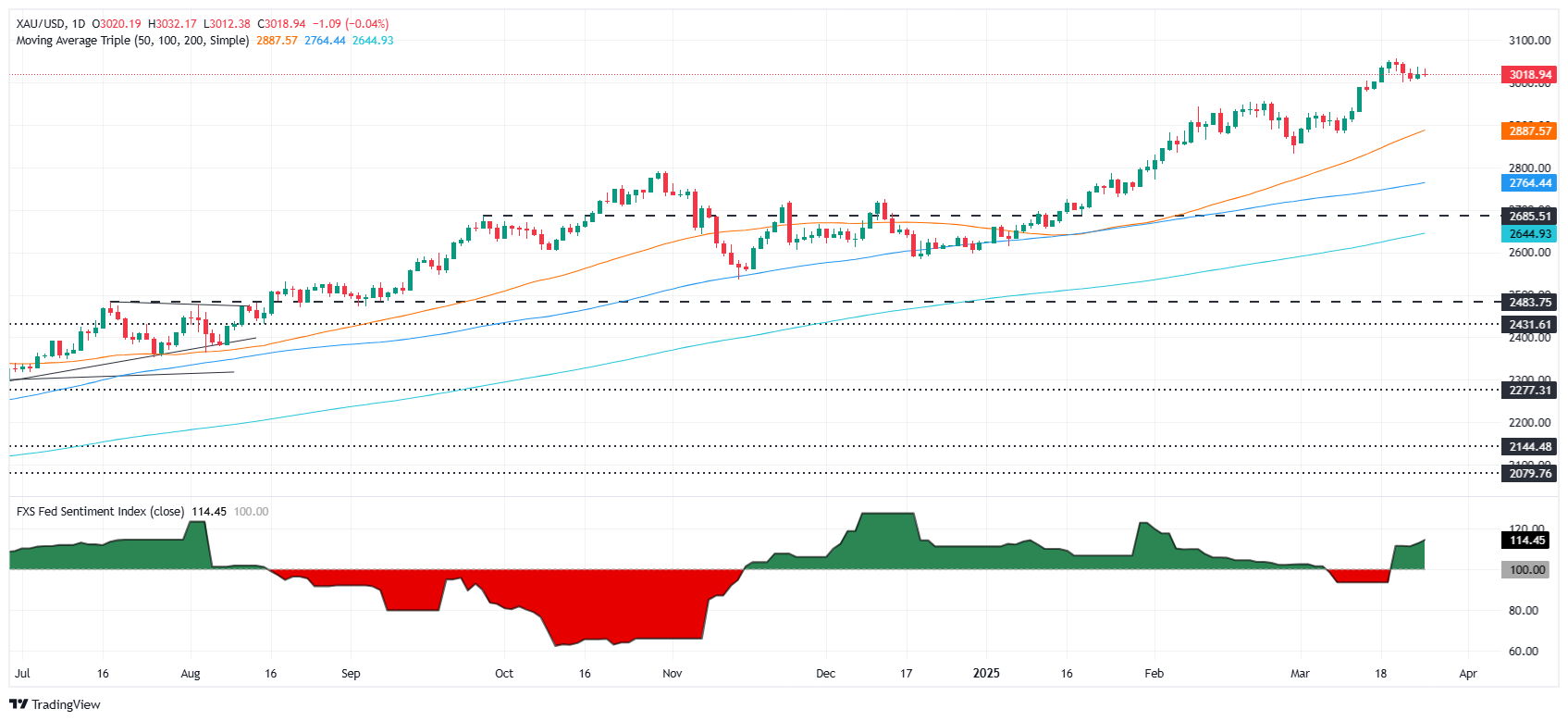Gold price stalls near $3,020 as market braces for Trump’s tariffs on autos

- Gold price struggles to gain traction as USD recovers despite firm support above $3,000 and cautious Fed tone.
- The US Dollar rebounds following reports of Trump auto tariff announcement.
- Solid Durable Goods data, Fed comments on sticky inflation limit upside for Bullion bulls.
Gold price has flat-lined late in the North American session, capped by the recovery of the US Dollar Index (DXY), which fell to a low of 104.18 before staging a recovery. The move was sponsored by the White House, which said that President Donald Trump would announce automobile tariffs at around 22:00 GMT. At the time of writing, XAU/USD trades at $3,019, virtually unchanged.
Bullion traders failed to gain traction on headlines that Trump is considering announcing limited tariff plans and automotive tariffs, according to The Wall Street Journal. In the meantime, the US Dollar Index (DXY), which tracks the performance of the Greenback against six currencies, rises 0.32% to 104.55.
Even though the Gold price has remained mildly, downwardly pressured, the precious metal remains firmly above the $3,000 support level, which keeps buyers hopeful of achieving higher prices.
In the data space, US Durable Goods Orders were solid in February, according to the US Department of Commerce. Aside from this, Federal Reserve (Fed) officials continued to grab the headlines with comments from the St. Louis Fed’s Alberto Mussalem and the Minneapolis Fed’s Neel Kashkari.
Musalem said that the labor market is close to full employment and underscored that current policy is appropriate, given that inflation is above target. He added that the risks of inflation stalling above 2% or rising further had increased, while stating that he doesn’t foresee a recession.
Earlier, Minneapolis Fed President Neel Kashkari stated that the Fed has made notable progress in curbing inflation. However, more work remains, Kashkari said, acknowledging that policy dynamics are making the Fed’s job more complex. Nevertheless, he expressed confidence that within the next year or two the central bank should be able to begin reducing interest rates.
Meanwhile, money markets have priced in 64.5 basis points of Fed easing in 2025, according to Prime Market Terminal interest rate probabilities.
Ahead this week, traders are eyeing the release of the Fed’s preferred inflation gauge, the core Personal Consumption Expenditures (PCE) Price Index.
Daily digest market movers: Gold price trades firm near $3,000, unfazed by Trump’s comments
- The US 10-year T-note yield is almost flat, up one basis point at 4.338%. US real yields edges down one bp to 1.973%, according to US 10-year Treasury Inflation-Protected Securities (TIPS) yields.
- US Durable Goods Orders posted a solid performance in February, rising 0.9% MoM, defying expectations of a 1% decline.
- Core Durable Goods Orders, which exclude transportation, also impressed — climbing 0.7% MoM, up from 0.1% in January and well above the 0.2% forecast, signaling resilient business investment.
- On Monday, Atlanta Fed President Raphael Bostic stated that he supports only one rate cut this year and doesn’t expect inflation to return to target until around 2027.
XAU/USD technical outlook: Gold price hovers near $3,020
Gold price trades choppy on Wednesday with the market awaiting a fresh catalyst that could push prices toward record highs or break the strong floor at $3,000. The Relative Strength Index (RSI) is bullish but turned flat after edging lower in back-to-back days, an indication that sellers lost strength.
That said, if XAU/USD clears the current week’s high of $3,036, that could exacerbate a test of the record high price at $3,057. A breach of the latter will pave the way for testing $3,100. Conversely, if Gold slumps beneath $3,000, this will expose the February 24 swing high at $2,956, followed by the $2,900 mark and the 50-day Simple Moving Average (SMA) at $2,887.
Fed FAQs
Monetary policy in the US is shaped by the Federal Reserve (Fed). The Fed has two mandates: to achieve price stability and foster full employment. Its primary tool to achieve these goals is by adjusting interest rates. When prices are rising too quickly and inflation is above the Fed’s 2% target, it raises interest rates, increasing borrowing costs throughout the economy. This results in a stronger US Dollar (USD) as it makes the US a more attractive place for international investors to park their money. When inflation falls below 2% or the Unemployment Rate is too high, the Fed may lower interest rates to encourage borrowing, which weighs on the Greenback.
The Federal Reserve (Fed) holds eight policy meetings a year, where the Federal Open Market Committee (FOMC) assesses economic conditions and makes monetary policy decisions. The FOMC is attended by twelve Fed officials – the seven members of the Board of Governors, the president of the Federal Reserve Bank of New York, and four of the remaining eleven regional Reserve Bank presidents, who serve one-year terms on a rotating basis.
In extreme situations, the Federal Reserve may resort to a policy named Quantitative Easing (QE). QE is the process by which the Fed substantially increases the flow of credit in a stuck financial system. It is a non-standard policy measure used during crises or when inflation is extremely low. It was the Fed’s weapon of choice during the Great Financial Crisis in 2008. It involves the Fed printing more Dollars and using them to buy high grade bonds from financial institutions. QE usually weakens the US Dollar.
Quantitative tightening (QT) is the reverse process of QE, whereby the Federal Reserve stops buying bonds from financial institutions and does not reinvest the principal from the bonds it holds maturing, to purchase new bonds. It is usually positive for the value of the US Dollar.
